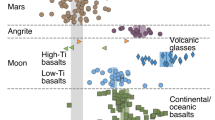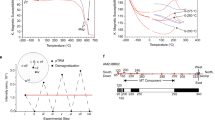Abstract
MOST of the secondary or chondritic meteorites are composed of irregular grains of silicate, sulphide, phosphide, oxide and metal phases. They are generally thought to be fragments of secondary meteorite bodies which were themselves accumulations of debris from disrupted primary bodies. The process of compaction of the secondary bodies does not appear to have been accompanied by sufficient heating to have melted any of the constituent phases1,2, which leads to the general conclusion that these secondary bodies did not have fluid, conducting cores capable of producing terrestrial-type magnetic fields, as is possible in the primary meteorite bodies3. This implies that alignment of magnetic particles or induction of thermo-remanent or chemical magnetization is unlikely to have occurred in the secondary bodies and therefore that the chondritic meteorites would not be expected to have magnetic moments other than those acquired on the Earth.
This is a preview of subscription content, access via your institution
Access options
Subscribe to this journal
Receive 51 print issues and online access
$199.00 per year
only $3.90 per issue
Buy this article
- Purchase on Springer Link
- Instant access to full article PDF
Prices may be subject to local taxes which are calculated during checkout
Similar content being viewed by others
References
Lovering, J. F., Geochim. et Cosmochim. Acta, 12, 253 (1957).
Urey, H. C., Astrophys. J., 124, 623 (1956).
Lovering, J. F., Amer. J. Sci. (in the press).
Wahl, W., Geochim. et Cosmochim. Acta, 2, 91 (1952).
White, H. P., Rec. Geol. Surv. N.S.W., 7, 312 (1904).
Jaeger, J. C., Lovering, J. F., and Parry, L. G. (to be published).
Stacey, F. D. (to be published).
Haigh, G., Phil. Mag., 3, 267 (1958).
Author information
Authors and Affiliations
Rights and permissions
About this article
Cite this article
STACEY, F., LOVERING, J. Natural Magnetic Moments of Two Chondritic Meteorites. Nature 183, 529–530 (1959). https://doi.org/10.1038/183529a0
Issue Date:
DOI: https://doi.org/10.1038/183529a0
This article is cited by
-
Paleomagnetic Records of Meteorites and Early Planetesimal Differentiation
Space Science Reviews (2010)
-
Demonstration of the Production of A New Type of Remanent Magnetization: Inversed Type of Thermo-Remanent Magnetization
Nature (1963)
-
Upper Atmosphere Density Variations Due to Hydromagnetic Heating
Nature (1959)
Comments
By submitting a comment you agree to abide by our Terms and Community Guidelines. If you find something abusive or that does not comply with our terms or guidelines please flag it as inappropriate.



